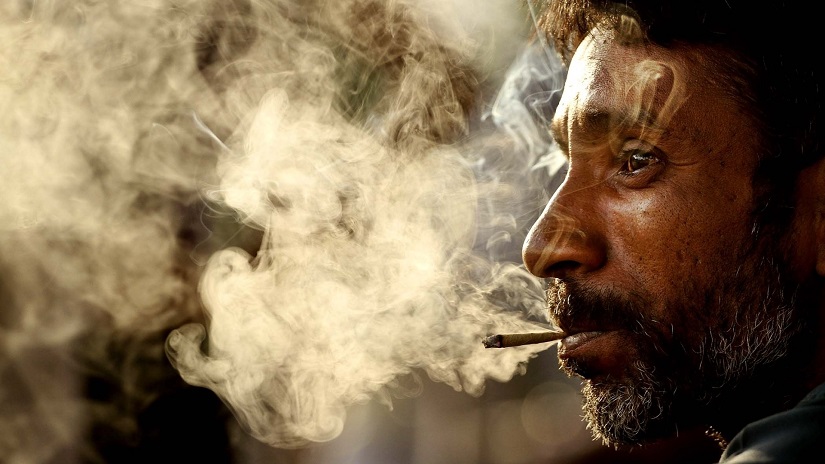The Troubling Ts: Tuberculosis & Tobacco

Do you recall reading “smoking is injurious to health” each time a character on screen smokes a cigarette or chews tobacco? While filmmakers use smoking as a character trait to flesh out the nuance of their films, the little warning on the side reminds you of the real threat such habits pose to our collective health.
Tuberculosis (TB), a preventable and curable disease, killed 1.6 million people in 2021 and is the second leading infectious killer after COVID-19.
Our health system’s response to the COVID-19 outbreak clearly demonstrates the capacity for tackling and eliminating TB globally, which is why WHO’s ‘End TB strategy’ should not be as daunting. However, leading factors that cause TB are part of the problem that propagates its pervasive nature, some of which include smoking, malnourishment, and alcohol consumption.
Evidence suggests that 1.3 billion people smoke tobacco products, and most of them live in low- or middle-income countries, where the burden of TB is also very high. For example, 267 million Indians use tobacco, which works in tandem with the fact that India has the highest burden of TB, with two deaths occurring every three minutes because of it. Furthermore, data suggests that 7.9% of TB-related deaths are caused by tobacco.
Despite the graphic warnings on tobacco products, why is it so difficult to quit tobacco if the outcome is so catastrophic?
For many, smoking tobacco decreases anger and stress and improves concentration, thereby literally manifesting the phrase, ‘blowing off some steam.’
Tobacco products contain nicotine, which is known to be just as, if not more, addictive than drugs such as cocaine and heroin. It stimulates pleasant feelings in the brain, thereby reducing anxiety, stress, or sadness. However, these pleasant feelings are so short-lived that users are compelled to seek out more to feel better again, resulting in a dependency that can lead to fatal diseases such as tuberculosis.
For those who try to quit smoking, withdrawal symptoms such as irritability, mood depression, anxiety, inability to socialize, increased appetite or desire to eat, and sleeplessness may manifest.
It doesn’t help when smoking is subject to habituation and conditioning. People habitually smoke in specific situations, such as after a meal, with a cup of coffee or an alcoholic drink, or in the company of friends who smoke.
Sociological factors also contribute significantly to developing smoking habits.
The social meaning of smoking in the context of people’s everyday lives is underplayed and often neglected in addressing tobacco control policies.
Do you recall cautionary advertisements played before a movie screening issuing a public warning against the dangers of smoking and consuming tobacco products? A father watching his kids cough because of the secondhand smoke his cigarettes produced is still one of the most dominant images that come to mind in such a category.

However, real life is not as simple. If cautionary tales were enough, we’d live in a utopic world. Many quote peer pressure as a mainstream reason why young people smoke, but the problem is more institutional than that.
In India, tobacco consumption is more prevalent among the disadvantaged group, who face higher exposure to tobacco harm. A study reviewed that populations with lower socioeconomic status find it difficult to quit smoking due to the following:
- reduced community support for quitting,
- less motivation to quit,
- powerful addiction,
- more likelihood of not completing pharmaceutical and behavioral interventions for tobacco quitting,
- psychological problems such as lack of self-efficacy, and
- tobacco industry marketing.
For India, the situation is contextually complex.
In India, multiple forms of tobacco exist, and each kind has varying acceptability in society. For example, smoking tobacco is looked down upon; however, chewing it has greater acceptability, evidenced by its prevalence in the nation’s cultural history. Two out of every three people who chew tobacco in the world are Indians. Paan consumption became a very common form of tobacco use in India, especially during the Mughal era.
The intersectionality of other determinants also makes it difficult for simple interventions to reach people needing support. Some of the other determinants of tobacco use include:
- gender,
- wealth index,
- caste position,
- peer pressure,
- exposure,
- advertisements,
- parental use, and
- lack of awareness.
Myths and stigma surrounding TB affect people directly, which is why many diagnosed with the disease do not seek any help and choose to dismiss it as a seasonal infection. In fact, studies have shown that over one lakh women are rejected by their families once they contract this disease. They wait up to twice as long to seek treatment, waiting until they are severely ill and more likely to die.
What’s the way out?
The problem is so institutional that merely creating cautionary advertisements will not lead to real change. Indian policies that ban smoking in public and levy increased cigarette taxes have not been as effective as desired. Evidence suggests that people switched to smoking bidis when cigarettes became unaffordable, hardly addressing the problem.
Tobacco is so endemic to TB and difficult to shake that interventions must be more behavior focused. While the National Tobacco Control Program (NTCP) has been working to create public awareness to encourage behavior change, what’s necessary is adding tobacco cessation programs to curb this vicious TB tide. Increased focus on group-based interventions, wherein support from families, neighbors, primary health care providers, and the local community is critical to creating an environment where quitting tobacco becomes possible.
The Indian Government also launched the TB-free India campaign, promising to eliminate the disease by 2025, five years sooner than the global target. For this to become a reality, we need to understand that addiction cannot be called a choice; it’s a mental disease that can happen to anyone and needs appropriate medical intervention to help individuals worldwide.
References:
https://www.ncbi.nlm.nih.gov/books/NBK499915/
https://tobaccoatlas.org/challenges/marketing/
Aishwarya Bhatia, Sambodhi



